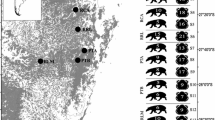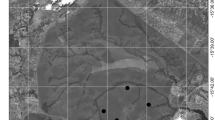Abstract
Understanding pattern and process at both regional and local scales is important for conservation planning although such knowledge of insects is frequently lacking. To assess patterns along a regional gradient of increasing aridity and diminishing food resources in the Botswana Kalahari, Scarabaeine dung beetles were sampled quantitatively using four dung types at three local sites in six regional areas. At regional scale, factor analysis of species abundance extracted a maximum of six factors, each dominated by a single area. Therefore, the statistical significance of regional spatial variation far outweighed that of dung type association. At local scale, six factor analyses of species abundance extracted from four to six factors. The importance of local dung type associations was relatively high but diminished with increasing local spatial heterogeneity. At regional scale, hierarchical analysis of oblique factors divided assemblages into unique local and shared regional components. Primary extended factors accounted for 40–50 % of unique local faunal composition in five out of six areas. Two secondary extended factors showed either high shared proportional contribution to regional assemblage structure in the northeast with a steep decline to the southwest, or an opposite trend. Their point of intersection was consistent with a boundary zone between mesic northeast and arid southwest faunal components in the central Kalahari. Despite some inconsistencies in rank position between regression methods, rainfall, temperature, and mammal density/diversity were the strongest influences on regional patterns defined by secondary factors. Patterns are discussed according to conservation and changes in land usage around reserves.







Similar content being viewed by others
References
Albertson A (1998) Northern Botswana veterinary fences: critical ecological impacts. http://www.stud.ntnu.no/~skjetnep/owls/fences/index.html. Accessed 8 October 2011
Botswana Central Statistics Organization (2005) Wildlife status report. Government Press, Gaborone, Botswana
Breiman L, Friedman JH, Olshen RA, Stone CJ (1998) Classification and regression trees. Chapman and Hall/CRC Press, Boca Raton, USA
Cambefort Y (1982) Les coléoptères Scarabaeidae s. str. de Lamto (Côte d’Ivoire): structure des peuplements et rôle dans l’écosystème. Ann Soc Entomol Fr 18:433–459
Cambefort Y (1991) Dung beetles in tropical savannas. In: Hanski I, Cambefort Y (eds) Dung beetle ecology. Princeton University Press, Princeton, pp 156–178
Campbell AC (1973) The national park and reserve system in Botswana. Biol Conserv 5:7–14
Chamaillé-Jammes S, Valeix M, Fritz H (2007) Managing heterogeneity in elephant distribution: interactions between elephant population density and surface-water availability. J Appl Ecol 44:625–633
Davis ALV (1994) Associations of Afrotropical Coleoptera (Scarabaeidae, Aphodiidae, Staphylinidae, Hydrophilidae, Histeridae) with dung and decaying matter: implications for selection of fly-control agents for Australia. J Nat Hist 28:383–399
Davis ALV (1995) Daily weather variation and temporal dynamics in an Afrotropical dung beetle community (Coleoptera: Scarabaeidae). Acta Oecol 16:641–656
Davis ALV (1996) Habitat associations in a South African, summer rainfall, dung beetle community (Coleoptera: Scarabaeidae, Aphodiidae, Staphylinidae, Histeridae, Hydrophilidae). Pedobiologia 40:260–280
Davis ALV (1997) Climatic and biogeographical associations of southern African dung beetles (Coleoptera: Scarabaeidae s. str.). Afr J Ecol 35:10–38
Davis ALV (2002) Dung beetle diversity in South Africa: influential factors, conservation status, data inadequacies and survey design. Afr Entomol 10:53–65
Davis ALV, Scholtz CH (2001) Historical versus ecological factors influencing global patterns of scarabaeine dung beetle diversity. Divers Distrib 7:161–174
Davis ALV, van Aarde RJ, Scholtz CH, Delport JH (2003) Convergence between dung beetle assemblages of a post-mining chronosequence and unmined dune forest. Restor Ecol 11:29–42
Diniz-Filho JAF, de Marco JrP, Hawkins BA (2010) Defying the curse of ignorance: perspectives in insect macroecology and conservation biogeography. Insect Conserv Divers 3:172–179
Dormont L, Jay-Robert P, Bessière J-M, Rapior S, Lumaret J-P (2010) Innate olfactory preferences in dung beetles. J Exp Biol 213:3177–3186
FAO/IIASA/ISRIC/ISSCAS/JRC (2012) Harmonized world soil database (version 1.21). FAO, Rome, Italy and IIASA, Laxenburg, Austria
Fincher GT (1973) Nidification and reproduction of Phanaeus spp. in three textural classes of soil (Coleoptera: Scarabaeidae). Coleopts Bull 27:33–37
Haddon IG, McCarthy TS (2005) The Mesozoic-Cenozoic interior sag basins of Central Africa: the Late-Cretaceous-Cenozoic Kalahari and Okavango basins. J Afr Earth Sci 43:316–333
Halffter G, Favila ME (1993) The Scarabaeinae (Insecta: Coleoptera) an animal group for analysing, inventorying and monitoring biodiversity in tropical rainforest and modified landscapes. Biol Int 27:15–21
Hanski I, Cambefort Y (1991) Competition in dung beetles. In: Hanski I, Cambefort Y (eds) Dung beetle ecology. Princeton University Press, Princeton, pp 305–329
Hawkins BA (2012) Eight (and a half) deadly sins of spatial analysis. J Biogeogr 39:1–9
Jankielsohn A, Scholtz CH, Louw SVDM (2001) Effect of habitat transformation on dung beetle assemblages: a comparison between a South African nature reserve and neighboring farms. Environ Entomol 30:474–483
Larsen TH, Forsyth A (2005) Trap spacing and transect design for dung beetle biodiversity studies. Biotropica 37:322–325
Livingstone DA (1975) Late Quaternary climatic changes in Africa. Annu Rev Ecol Evol Syst 6:249–280
Lobo JM, Hortal J, Cabrero-Sañudo FJ (2006) Regional and local influence of grazing activity on the diversity of a semi-arid dung beetle community. Divers Distrib 12:111–123
Lumaret JP, Kadiri N, Bertrand M (1992) Changes in resources: consequences for the dynamics of dung beetle communities. J Appl Ecol 29:349–356
Main M (1987) Kalahari: Life’s variety in dune and delta. Southern Book Publishers, Johannesburg
Mbaiwa JE, Mbaiwa OI (2006) The effects of veterinary fences on wildlife populations in Okavango Delta, Botswana. Int J Wilderness 12:17–23, 41
McGahey DJ (2011) Livestock mobility and animal health policy in southern Africa: the impact of veterinary cordon fences on pastoralists. Pastor Res Policy Pract 1:14, 1–29. Open access http://www.pastoralismjournal.com/content/1/1/14
Ministry of Environment, Wildlife and Tourism (2004) Department of Wildlife and National Parks census report. Government Press, Gaborone, Botswana
Moleele NM, Mainah J (2003) Resource use conflicts: the future of the Kalahari ecosystem. J Arid Environ 54:405–423
Moyo S, O’Keefe P, Sill M (1993) The Southern African environment: profiles of the SADC countries. Earthscan Publications Ltd, London
National Geographic (2001) Terrestrial ecoregions of the world. http://www.nationalgeographic.com/wildworld/terrestrial.html. Accessed 8 October 2011
Nealis VG (1977) Habitat associations and community analysis of south Texas dung beetles (Coleoptera: Scarabaeinae). Can J Zool 55:138–147
Olson DM, Dinerstein E, Wikramanayake ED, Burgess ND, Powell GVN, Underwood EC, d’Amico JA, Itoua I, Strand HE, Morrison JC, Loucks CJ, Allnutt TF, Ricketts TH, Kura Y, Lamoreux JF, Wettengel WW, Hedao P, Kassem KR (2001) Terrestrial ecoregions of the world: a new map of life on earth. Bioscience 51:933–938
Peck SB, Howden HF (1984) Response of a dung beetle guild to different sizes of dung bait in a Panamanian rainforest. Biotropica 16:235–238
Penry H (1994) Bird atlas of Botswana. University of Natal Press, Pietermaritzberg, South Africa
Perkins JS (1996) Botswana: fencing out the equity issue. Cattleposts and cattle ranching in the Kalahari Desert. J Arid Environ 33:503–517
Skinner JD, Chimimba CT (2005) The mammals of the southern African subregion (3rd edn). Cambridge University Press, Cambridge
Spector S (2006) Scarabaeine dung beetles (Coleoptera: Scarabaeidae: Scarabaeinae): an invertebrate focal taxon for biodiversity research and conservation. Coleopts Bull Monogr 5:71–83
Stokes S, Haynes G, Thomas DSG, Horrocks JL, Higginson JM, Malifa M (1998) Punctuated aridity in southern Africa during the last glacial cycle: the chronology of linear dune construction in the northeastern Kalahari. Palaeogeogr Palaeocl 137:305–322
Strayer DL, Power ME, Fagan WF, Pickett STA, Belnap J (2003) A classification of ecological boundaries. Bioscience 53:723–729
Tscharntke T, Tylianakis JM, Rand TA, Didham RK, Fahrig L, Batáry P, Bengtsson J, Clough Y, Crist TO, Dormann CF, Ewers RM, Fründ J, Holt RD, Holzschuh A, Klein AM, Kleijn D, Kremen C, Landis DA, Laurance W, Lindenmayer D, Scherber C, Sodhi M, Steffan-Dewenter I, Thies C, van der Putten WH, Westphal C (2012) Landscape moderation of biodiversity patterns and processes - eight hypotheses. Biol Rev 87:661–685
Tshikae BP (2011) Local and regional factors influencing dung beetle assemblage structure across an environmental gradient in Botswana. PhD thesis, University of Pretoria, South Africa. http://upetd.up.ac.za/thesis/available/etd-10192011-133622/
Tshikae BP, Davis ALV, Scholtz CH (2008) Trophic associations of a dung beetle assemblage (Scarabaeidae: Scarabaeinae) in a woodland savanna of Botswana. Environ Entomol 37:431–441
Tshikae BP, Davis ALV, Scholtz CH (2013) Does an aridity and trophic resource gradient drive patterns of dung beetle food selection across the Botswana Kalahari? Ecol Entomol 38:83–95. doi:10.1111/j.1365-2311.2012.01409.x
Tyson PD (1986) Climatic change and variability in Southern Africa. Oxford University Press, Cape Town
Verlinden A, Masogo R (1997) Satellite remote sensing of habitat suitability for ungulates and ostrich in the Kalahari of Botswana. J Arid Environ 35:563–574
Wallgren M, Skarpe C, Bergström R, Danell K, Bergström A, Jakobsson T, Karlsson K, Strand T (2009) Influence of land use on the abundance of wildlife and livestock in the Kalahari, Botswana. J Arid Environ 73:314–321
Walter H, Lieth H (1964) Klimadiagramm-Weltatlas. Gustav Fischer, Jena
Wherry RJ (1984) Contributions to correlational analysis. Academic Press, New York
Wit PV, de Bekker RP (1990) Land systems map of the Republic of Botswana. Soil mapping and advisory services project AG:DP/BOT/85/011. FAO, Ministry of Agriculture, Gaborone. http://eusoils.jrc.ec.europa.eu/esdb_archive/eudasm/africa/lists/cbw.htm. Accessed 8 October 2011
Acknowledgments
We thank the GEF-Small Grant Programme and the University of Pretoria for funding and the government of Botswana for permission to conduct research in Chobe National Park, Central Kalahari Game Reserve and Kgalagadi Transfrontier Park. We also thank Park staff for providing necessary information and camping facilities, members of the Scarab Research Group for support in field trips, and McDonald Mokhatla for sorting the samples.
Author information
Authors and Affiliations
Corresponding author
Electronic supplementary material
Below is the link to the electronic supplementary material.
Rights and permissions
About this article
Cite this article
Tshikae, B.P., Davis, A.L.V. & Scholtz, C.H. Dung beetle assemblage structure across the aridity and trophic resource gradient of the Botswana Kalahari: patterns and drivers at regional and local scales. J Insect Conserv 17, 623–636 (2013). https://doi.org/10.1007/s10841-013-9547-y
Received:
Accepted:
Published:
Issue Date:
DOI: https://doi.org/10.1007/s10841-013-9547-y




